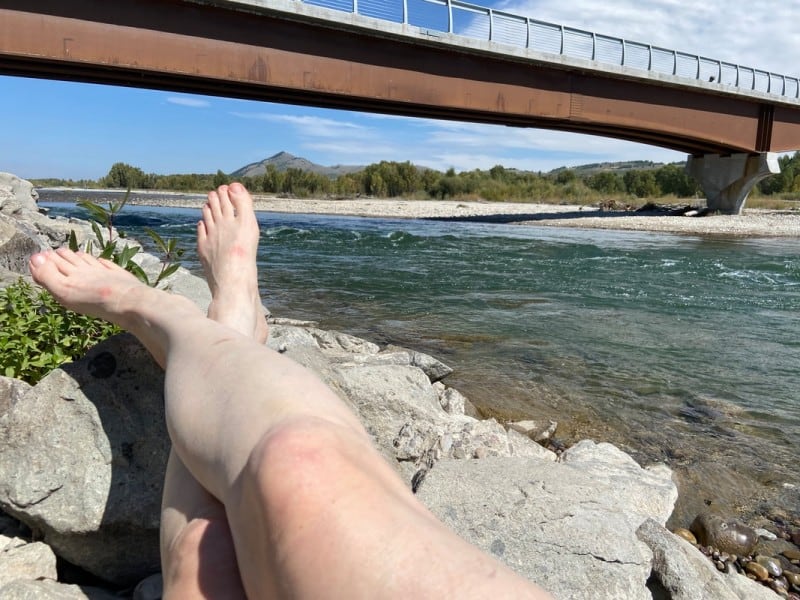In this video, we talk about pacing and graded exposure for my patients and anyone else who has long-term pain. You’ve paced your home exercises, so you don’t hurt yourself again or have a flare-up. I want to talk to you about how to safely get back to your daily activities.
When you’re healthy, your body has a “tissue tolerance line” that tells you how much force you can take before you get hurt.
There is a “pain line” below that. When people are younger and run through a playground or a field at home and twist their ankles, they fall and are in terrible pain, hold their ankles and cry out. They look at it, step on it carefully, and decide it’s fine. So, they’ve reached the “protect-by-pain line,” but not the “tissue tolerance line.” Their body told them it’s safe to keep going.
People with chronic pain often go beyond the pain threshold. We live there. We have to get up, take a shower, and go to the doctor, so we can’t stop. We can’t stop just to be safe. We’re still at the “protect-by-pain” line. Even though it’s awful, we’re still safe because the “tissue tolerance line” is higher. The body adds a second “protect-by-pain line” because we are always in pain, called the “flare-up line,” which is closer to “tissue tolerance.”
We’ve all done too much in one day and felt bad, with increased pain and symptoms for three or four days. We’ve reached the “flare-up line.” Most likely, we still didn’t go past the “tissue tolerance line.” Safe. No damage. We might ask if we did any damage, but it’s likely that we didn’t. Our bodies tell us to slow down, but we can’t. We went too far, in our body/brain’s opinion. If we do more, our tissues will get hurt.
With this in mind, we have “protect-by-pain lines” that are well below any “tissue tolerance line” or any place that will actually harm us. Let’s talk about the “specific adaptations to imposed demands” principle. If you’ve been in pain for a long time, it’s likely that you’ve slowed down. You’ve probably cut back on how much you eat or how much you do. People often find ways to lift less at work or ask for help, which are both good ideas. Nothing to be embarrassed about. If we don’t ask our bodies to do as much, they likely won’t be able to do as much. We never fall below the “protect by pain line.” The opposite is true if we ask our bodies to do more. This is how a bodybuilder builds muscle, by asking it to lift more and more. They have pain, as well, in the form of soreness. This is how a healthy body responds to increased demands.
We have an extra line to “protect by pain”. Our “flare-up line.” Our tissue tolerance line is up here when we’re healthy, but we don’t use our bodies as much as we used to. The “tissue tolerance line” is a little bit lower now. So the question is, how do we get these lines back to where they should be in a healthy body? Even though your tissues have had time to heal, they may not be as strong and healthy as they could be.
So the “tissue tolerance line” is much lower and the “protect-by-pain line” is a little bit higher. Your body’s way of staying alive is adapting to a recurring injury, so the “protect-by-pain line” may be even lower. In fact, we know that some people start to feel pain when they just think about doing something. Your brain and body are telling you, “No, you can’t do that. It will make things worse in the long run.” We need to keep this in mind when doing more. We have a flare-up when we cross the “protect-by-pain” line and “flare-up” line. It knocks you out for a while, makes you feel hopeless, scared that you’ve harmed yourself, and worried that you’ll have to go through the pain and disability again. How long is this going to go on? How long will this last? Is there hope?
But remember that even if you hurt during a flare-up, you may not have done any damage. You’re safe because you’re below the “tissue tolerance line.” So, we’ll find the baseline, which will be above the first “protect-by-pain line.” It’s the amount of activity you can do during the week without having your symptoms get worse. Here is where you’ll go back to your regular life. You and your healthcare provider need to figure out your activity baseline, which is the least inflammatory thing you can do at this level.
Sometimes, you may have a flare-up even though you didn’t do anything out of the ordinary. This could be because you have a cold or because you are weak in some other way. You’re stressed out. We all know that that line can be hard to see. So, these things can happen. This baseline tells us where we can go and what we can do during the day without getting hurt. This level of activity doesn’t do any harm at all. This is based on how much activity you can do safely without making your symptoms worse.
On a good day, this should be an easy baseline. People see this and think, “Wow, I could do more,” so they want to do more. Happy day! They say, “Let’s go rake the leaves. Let’s make sure that both of those bathrooms and the kitchen are clean”, and then the next day they’ll feel terrible. If we can find this starting point and see that we can easily clean half the bathroom today, we can clean the other half tomorrow. So this isn’t based on how much your tissues hurt, but on what makes sense for your tissue health.
You know what hurts and plan your activities carefully to avoid flare-ups and build up your body’s ability to deal with pain. Based on this idea, tissues should be able to handle more movement and stress as they get used to it. We’ll touch, tease, and nudge it again. So, we have this starting point, and we’ll try to keep working at this level for a couple of weeks. And we’ll try to add one new thing or make one thing happen more often.
For example, each week, a woman could only do one load of laundry. So we increased it by every six days. She would do one load. When that got easier, she did one load of laundry once every five days. Increasing this activity is easy.
A word about flare-ups – Relax. Be calm. If you feel like you’re about to panic, call your therapist or someone else who is helping you with this. Your brain and body are just trying to tell you not to do too much too soon.
Take care of yourself and remember that you’re getting better. By pushing, you’re making those tissues stronger. We want to take a baseline-level activity. I suggest three days’ worth of activities. They don’t have to be consecutive days because sometimes it can be depressing to notice that you can handle doing one outing a day and that’s it. Or one outing every other day and that’s it.
We want to take small steps to do a little more than we did yesterday or last week. You can go as fast as you feel comfortable with. As we apply more pressure, the “protect-by-pain line” should slowly start to move up, letting you do more activity. With this kind of training, the “tissue tolerance line” will go up because it makes tissues stronger, more fit, and easier to control. We’re imposing more demands, so your body will adapt.



